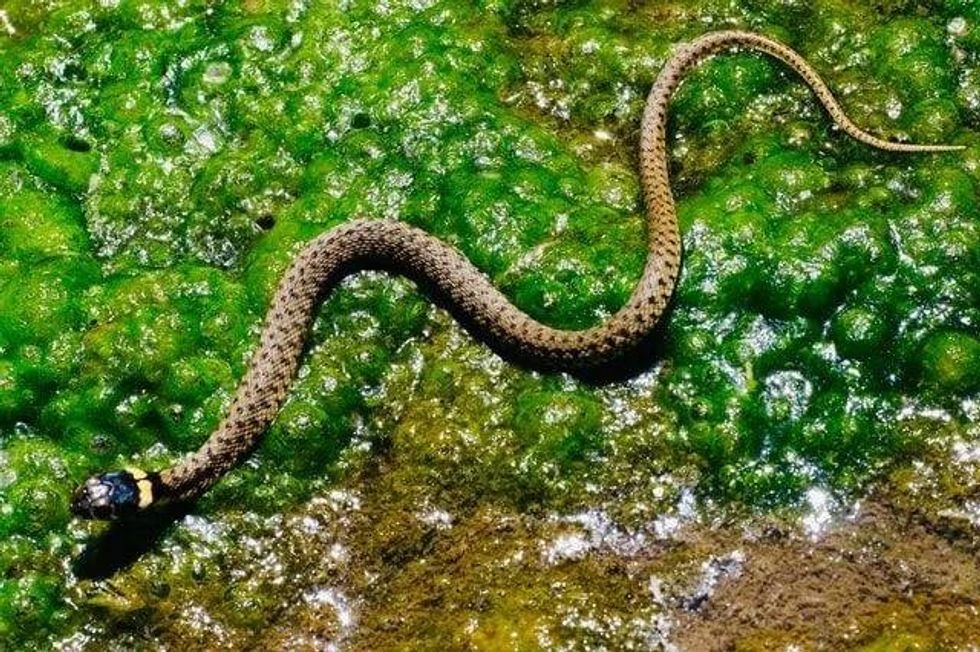Snakes are mysterious and terrifying animals in the world.
They are elusive and enchanting species that are often misunderstood by their appearance. Some people like them while many feel creepy, but they play a vital role in our ecosystem.
Snakes are predatory animals that belong to the reptile class, including lizards, crocodiles, and turtles. They are cold-blooded animals with slender, elongated bodies without limbs and are covered with crisscrossing scales.
Scientific studies reveal that snakes are the descendants of lizards. There are over 3900 snake species found throughout the world except for Antarctica. Most snakes are terrestrial animals, and some species are known to live in water as well. Snakes inhabit almost everywhere, in forests, deserts, streams, lakes, and oceans. They live on trees, land, and in water.
The snake's vertebral column is highly elongated and has over 600 bones more than any other living animal. These creatures lack eyelids and eardrums but possess inner ears, which enable them to pick up even low-frequency airborne sounds and ground-borne vibrations.
Most of the people in the world feel anxious about snakes, and it is pretty common. But extreme fear of snakes is is a kind of phobia called Ophidiophobia. Keep scrolling to understand more about snakes and the purpose of their tails.
If you are interested in more similar articles about snakes, do check what do corn snakes eat? and what do garden snakes eat?
Do any snakes have venom in their tails?
The snake has an elongated tubular body with a head and tail. Compared to other animals like dogs or cats, the snake's body makeup may seem confusing to identify where its tail starts. However, if you understand, snakes have clear defined tails.
At first glance, a snake's body may appear to be one giant tail. But the snake's tail starts from the cloaca, a hole through which urinary waste, feces, and reproduction occur.
It is also from where the ribs stop. The length of their tail varies depending on the species. Arboreal snakes are known to have a tail that is half the length of their entire body.
It is a myth that snakes have venom in their tails to poison prey or a human. However, the reality is snakes process venom in the salivary glands behind their heads and not in their tails. Some snakes might have pointed tails, but they do not possess stingers like wasps and bees.
In most species, male snakes have longer tails than female snakes, even if they have the same body length. The variation in the tail's length of the female and male snakes is due to sexual dimorphism.
Male snakes have a hemipenis at the end of their tail, due to which their tail appears larger than females. A snakelet will not have the same tail length as its adults.
Different species of snakes grow in different body sizes that make a vast difference in their tails. Some snakes have shorter tails, while other huge species like the anaconda have a foot or more long tail.
Do poisonous snakes have blunt or pointed tails?
Among the 3000 snake species, around 600 species are poisonous, and all other snakes are non-poisonous. Globally, the inland taipan is the most poisonous snake, including rattlesnakes, copperheads, blue krait, cobras, vipers, and mambas. The giant non-poisonous snakes are pythons, boas, and anaconda.
A snake's tail is not poisonous. Even rattlesnakes, which are venomous and have pointed tails store venom in its head and not the tail. Therefore, a pointed or blunt snake's tail will not determine whether the snake is venomous or non-venomous.
Generally, to distinguish whether a snake is poisonous or non-poisonous, we need to assess their behavior, which is the primary component that helps identify. For example, a rattlesnake shakes the rattle on its tail to produce a rattling sound to warn its predator.
Secondly, the habitat or geographic location of the snake is also helpful in deciding. For example, copperheads live in forest areas near rivers.
The shape of a snake's head is another way; a venomous snake has a more triangular-shaped head while a non-venomous snake has a rounded head. Rattlesnakes, coral snakes are venomous snakes distinguished by the holes on their heads that appear on their snouts.
Another method is examining a snake's pupils. Non-venomous snakes have round pupils, while on the contrary poisonous snakes have black, thin, elliptical pupils enclosed within a green or yellow eyeball.
These identification methods require close observation, which is potentially dangerous. Thus, a professional snake specialist should be considered to identify instead of taking the risk.
Do copperhead snakes have yellow tails?

Snakes use their tails to perform several roles that limbs play in other animals - for instance, mimicking prey during a hunt, grasping onto things, swimming, defending against predators, climbing, constricting, and as a communication device. Sea snakes use their side-flattened tail as a fin for swimming in water.
A snake's tail is more like a human limb, and without it, the snake would be significantly paralyzed.
Copperhead snakes are venomous species endemic to North America. These are medium-sized snakes whose bodies are distinctly patterned with brown hourglass-shaped crossbands.
Adult snakes do not have yellow tails but have one to three crossbands followed by a gray area. Like most other vipers, when closely approached, copperheads also exhibit defensive tail vibration behavior. A copperhead snake's tail can vibrate 40 times per second, faster than other non-rattlesnake species.
Many snake species use their tails to attract, strike on their prey, and this act of mimicry is caudal luring. Some studies show that males have longer tails than a female's tail, and snakes with shorter tails are less successful with mating and reproduction.
Do baby copperhead snakes have yellow tails?
Did you know that the female King cobra is the only snake that builds a nest? It does this only before laying eggs. The female snake uses materials like weeds, dry leaves, and other rotting vegetation. Isn't it fascinating that a limbless animal is building a nest!
Young baby copperheads are grayish, unlike adults, and have a bright yellow or greenish tail. However, their yellow-tail will change to natural color like the adults in about a year.
Baby copperheads use their tail to lure lizards, frogs, and other animals for their food. They wiggle their bright-colored tip of the tail hiding in the grass so that it resembles a worm, and wait for their prey.
The pointy and greenish-yellow tail of copperhead is often misunderstood as a venomous tail and could sting humans. However, this species is venomous and will bite you, but it doesn't indicate that copperhead tails are poisonous.
Did you ever imagine that snakes fart, too? Snakes use fart as a defense mechanism. They suck air into their cloaca and then push it back out to escape from their predators.
Why do snakes eat their own tails?
Amid different vertebrate animals, snakes don't have necks. Instead, their head is directly hooked to their bodies, which have the appearance of a long neck. A neck rises out of a pectoral girdle, but snakes lack this feature. Thus cannot have a neck like other creatures, but all snakes have tails.
An ancient symbol illustrating a snake eating its tail called the ouroboros was adopted notably in alchemy. But do really snakes eat their own tails? The answer is yes; due to environmental, heating, and stress factors, this can happen.
When a snake is kept in captivity, it cannot move around. Snakes are cold-blooded and thus rely on the outside environment to regulate their body temperature.
In captivity, this can be a stress trigger for them. This will make the snake bite into its tail until its body heat is regulated, but when the snake goes about eating its own tail, it will get hurt, suffer shock, and blood loss too. It may also end up losing its life.
Snakes belong to the reptile family, including lizards, skinks that can grow their tails back. However, snakes do not inherit this trait.
If a snake loses its tail, as, by nature, they are rapid healers, the snake heals itself and remains tail-less, but the snake's tail cannot regrow. However, if the injury is dreadful, then the snake cannot survive and loses its life.
Here at Kidadl, we have carefully created lots of interesting family-friendly facts for everyone to enjoy! If you liked our suggestions for do snakes have tails, then why not take a look at what do snakes eat or how do snakes reproduce?










